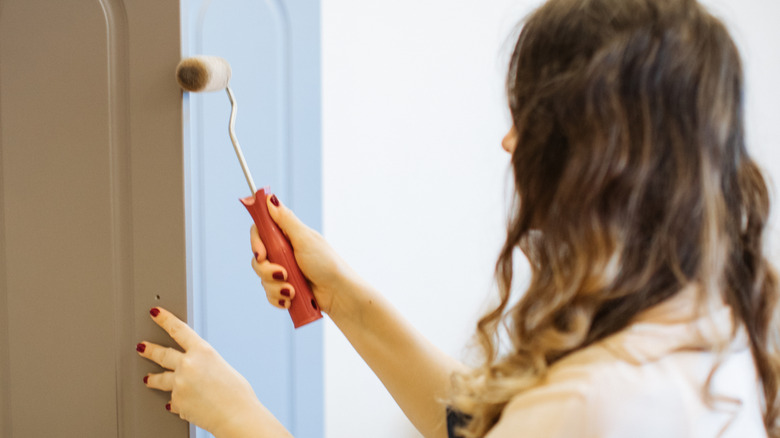Try A Paint Upgrade For Your Hallway Doors To End The Monochromatic Monotony
Thank goodness hallways can't talk. If they could, they'd probably say, "Is this it? Don't we deserve a little love? Some color, perhaps?" For many of us, the hallway tends to be one of the most uninteresting parts of a home. Maybe it's because since we enter and exit the space so quickly, it wouldn't make sense to go all out with pricey upgrades. Or, maybe your hallway is too narrow and awkwardly shaped, and you don't know where to start. Well, news flash: Hallway doors are a great canvas for color and creativity. Find your perfect color palette using the color wheel or opt for a bold contrast to decorate your boring hallway. Either way, this paint makeover sure beats staring at the same old white doors day after day.
Imagine a white-on-white hallway punctuated by dreamy blue, sleek black, or subtle beige doors. They could add character and bring some much-needed depth, and they're refreshing on the eyes. You don't even have to paint all of your interior doors the same color if you want to infuse this transitional area with playfulness. One surface could be dusty pink, another sage green, and the third mustard yellow — so long as the hues complement each other. Looks aside, this easy update can also enhance your doors' durability.
How to turn ordinary hallway doors into statement-makers
The first step is to pick a paint color and sheen that fits with your style and interior scheme. Note that the glossier the finish, the more durable the surface is against scratches and scuffs. A high-sheen paint is also easier to clean, though you can always go matte if you prefer a more modern (albeit less scuff-resistant) approach.
Next, decide how you want your paint job to look design-wise. You could stick to solid painted doors for an easy focal point, or if you're feeling adventurous, consider a two-tone design. Essentially, this means painting the top half of your door one shade and the bottom something else. Another possibility is to use a different color on the panels so it contrasts with the framework.
When you're ready to begin painting, you'll first need to prep the surface by lightly sanding it with 120-150 grit sandpaper. Wipe it with a cloth dampened with liquid sander deglosser or mineral spirits and let it dry. While you're at it, repair any chips, dents, and holes with wood filler. (You may need to re-sand these so everything's smooth and even.) Cover your hinges with painter's tape or aluminum foil, and remove the door knobs if possible. Don't forget to protect the floor with cardboard or newspaper, which is one of the clever tricks you need when painting your doors. Finally, apply a coat of primer, do a final round of sanding, and you're ready to paint.
